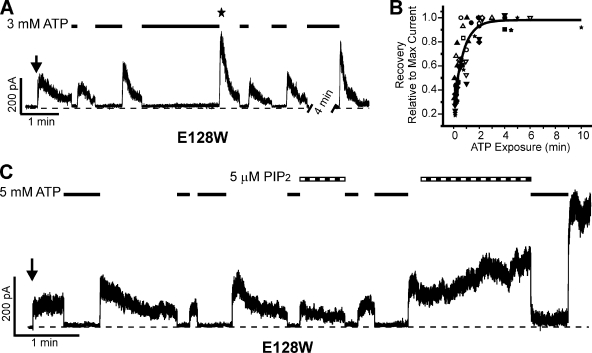Figure 8.
E128W causes KATP channel inactivation that can be recovered by ATP exposure and subsequent removal of ATP and can be reversed by PIP2. (A) Representative trace of inside-out voltage clamp experiment showing inactivation and the ability of ATP to “reset” the current upon reentry into ATP-free Kint/EDTA solution. The time of patch excision is denoted by the arrow, 3-mM ATP exposure by the black lines, and the zero current level by the dotted line. The maximal current for this record is indicated by the star. Bars: vertical, 200 pA; horizontal, 1 min. Note the break in trace during which ATP was applied. (B) The ability of high concentrations (1–5 mM) of ATP to reset the E128W KATP channel is illustrated by this scatter plot. Each symbol represents a different trace with several exchanges between ATP-containing and ATP-free Kint/EDTA solutions (the values for the trace in A are solid squares). 12 traces are represented. The amount of current upon reexposure to Kint/EDTA (y axis) is dependent on the length of time the patch is exposed to ATP (x axis). The collective dataset is well represented by an exponential fit. (C) Representative trace showing that exposure of the E128W KATP channels to 5 µM PIP2 (striped bars) decreased and reversed inactivation as well as increased the efficacy of ATP (black lines, 5 mM) to reset the channel. PIP2 also decreased the ability of ATP to inhibit channel activity, as seen after the second PIP2 exposure. Bars: 1 min and 200 pA.

